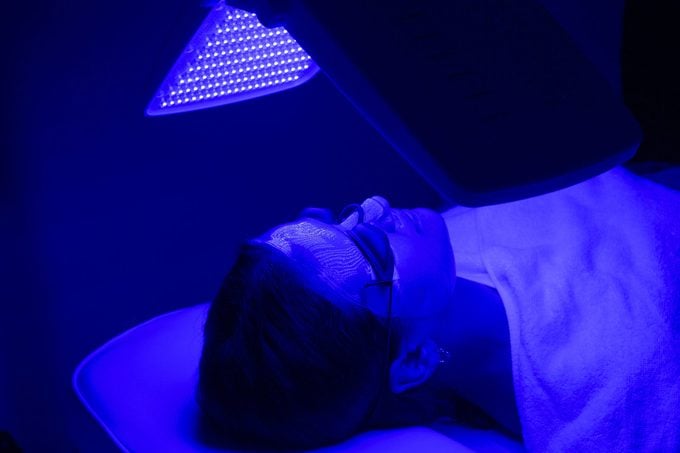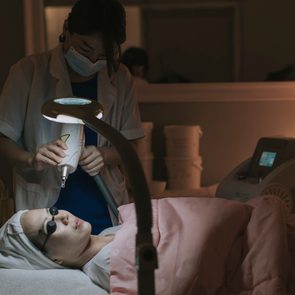What Is Blue Light Therapy?
Updated: Jun. 17, 2021
Blue light therapy can help treat skin conditions like acne and psoriasis—and it may even help beat seasonal affective disorder.
Using blue light therapy for your skin
You may’ve heard about blue light from your phone or other devices—it has a well-deserved reputation for keeping you wired and awake well past your bedtime. However, blue light can be therapeutic when it comes to certain conditions—especially when used for your skin.
Here’s what blue light therapy is, how it works, and its multiple uses for various skin and health conditions.
What is blue light therapy?
Blue light therapy is a non-invasive treatment that uses blue wavelength range. With this type of therapy, there is no recovery time and it’s typically used for people with moderate to severe acne. This treatment is most often administered at a dermatologist’s office or at home. It’s approved by the Food and Drug Administration (FDA).
High-intensity blue light is sometimes used to activate certain drugs. Called photodynamic therapy, this treatment can be used to eliminate cancerous and precancerous cells, according to the American Cancer Society. The light source to activate these photosynthesizing drugs can be blue or violet.
Blue light therapy sessions can range from 15 minutes to 90 minutes. How often you receive blue light therapy sessions depends on the treated area and its size.
Acne treatment with blue light therapy
Traditional acne treatment often focuses on topicals like benzoyl peroxide or salicylic acid to keep complexion clear. But blue light therapy might be a powerful alternative treatment to prevent breakouts.
“Blue light goes into the hair follicle and kills P. acnes bacteria, which is the bacteria that causes acne,” says Purvisha Patel, MD, board-certified dermatologist and founder of Visha Skincare in Germantown, Tennessee. (Here’s what to know about how to treat types of acne.)

How does blue light therapy for acne work?
There are two ways you can get blue light therapy for acne: through at-home over-the-counter devices and in-office treatments.
A 2019 review and meta-analysis in the Annals of Family Medicine didn’t find very promising results for at-home devices. Of the 14 trials analyzed, blue light LED treatment did not decrease inflammatory or non-inflammatory acne, though there was some evidence that patients themselves noticed a positive difference in their skin.
That said, the evidence is limited and there are questions about the quality of studies. Larger, longer-term trials are needed.
If you are interested in blue light therapy for acne, consider photodynamic therapy, which is an in-office treatment. This uses blue light to activate a medication applied to the skin with the goal of shrinking oil-producing glands in the skin. This procedure is performed in a darkened room. You’ll be given goggles to protect your eyes before they apply the light to the treatment areas.
Photodynamic therapy has been found to be effective for mild-to-severe acne, especially when topicals haven’t done much to help your skin, according to a 2017 study in the American Journal of Clinical Dermatology.
(Learn more about blue light therapy for acne.)
Psoriasis control with blue light therapy
Psoriasis, an autoimmune skin disease marked by patches of thick skin and silver scales, can also be treated with high-dose blue light in the doctor’s office, says Dr. Patel. Light therapy calms the disease process by preventing white blood cells from attacking skin, she explains. This treatment is especially useful when patches and scales or extreme itch is so widespread that it’s a challenge to use topicals to cover the entire area.
Typically, your doctor would recommend using light therapy in conjunction with other treatments, like biologic drugs. A 2017 study in the Journal of Comparative Effectiveness Research also suggests using blue light as a cost-effective treatment for psoriasis.
Better mood with blue light therapy
If you have seasonal affective disorder (SAD), you might have heard that bright white light therapy can effectively help lift your mood during the gloomy winter season. Interestingly, blue light may provide the same benefits, according to a 2018 study in the Journal of Affective Disorders. In the small study, 45 patients with SAD underwent 30-minute sessions of light treatment with white or blue light for five consecutive days. The outcome? Both types of light were equally highly effective in reducing mood symptoms. (These are the best light therapy lamps for SAD.)
How to get blue light therapy
For skin conditions, you can find blue light therapy as a treatment in your dermatologist’s office. There are also some at-home devices that you can buy and use on your own. Whether or not these will change your skin for the better isn’t clear.
“We don’t know how effective these LED masks and home devices are for treating skin conditions,” says Roger Ceilley, MD, a fellow of the American Academy of Dermatology who practices at Dermatology P.C. in West Des Moines, Iowa.
There is not a proven or recommended dosage of blue light in the treatment of acne, he says. Dr. Ceilley more often recommends topical acne treatments, and patients can use blue light therapy as an additional treatment if they’re interested.
If you want to try blue light for the treatment of other conditions, including SAD, talk to your doctor first about how it might fit in your current mental health plan. You’ll also want to discuss other health conditions that might make blue light a poor choice for you. For instance, blue light may trigger migraines in some people.
Side effects and risks of blue light therapy
When used according to directions or in an in-office setting, low doses of blue light won’t cause skin cancer, says Dr. Patel. (They don’t contain ultraviolet radiation or UV light.)
That said, it’s possible that your skin can be sensitive to anything and erupt in irritation or inflammation. Therefore, Dr. Ceilley recommends testing any treatment, including an at-home light device, on a small patch of skin (like the side of your cheek or the inside of your arm) to ensure that you won’t react to it.
However, if you are using a high dose of light to treat a skin condition, like psoriasis, your doctor will have you wear goggles to protect your eyes from possible damage. Also, avoid staring directly at the light.
In 2019, Neutrogena recalled its Light Therapy Acne Mask in response to complaints of possible eye irritation and visual discomfort. Always follow the directions on the product when using any at-home device.
The bottom line
Blue light may effectively treat acne and psoriasis, but it’s not yet clear how effective at-home devices are. This type of light therapy may also be useful to lift your mood during the winter months. While these products are safe overall, always check in with your doctor first.



















